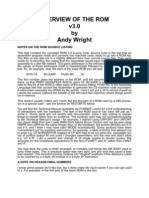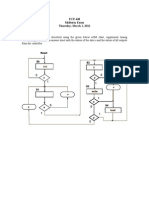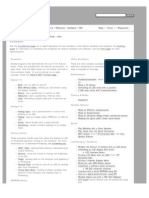Algorithmic State Machines
Uploaded by
luffydmonAlgorithmic State Machines
Uploaded by
luffydmonAlgorithmic State Machines
SD192 Digital Systems
Lecture notes
July 16, 2004
ASM Overview
Drawbacks of state diagrams for real
systems:
Many inputs & many outputs -> awkward
to list all of these as each transition arc.
On any given arc
Typically most inputs are dont care
Typically most outputs are unchanged from the
settings in the previous state
Tedious & repetitive to list exhaustively
ASM Overview
Not a clear structure for
illustrating/designing control flow
What about generic memory/data
Do they really need to be part of the state? If
we have many bits of data, this would lead to a
huge state
E.g. state diagram for counter or shift register
is pointless
ASM Overview
Some problems analogous to before
Combinational:
Small problems truth tables ok/easy
Adders, Muxes TT get out of hand
Sequential:
Small state diagrams easy
Real, Data state diagrams not helpful
ASM Overview
We need to separate controller & data
processor
Controller What actions need to be
taken? What is fundamental operating
mode?
Processor Undertake the action.
Manipulate the data
ASM Overview
Control and data path interaction
Data Processing
Control
Commands
Combinational
Status
Shift Registers.
Counters, Mux, etc.
I/O
Outside
World
State
Our circuit is now explicitly separated
ASM Overview
Ex. Serial Addition
Ctrln
Go=0
Start
Go=1
Load, Clear
Ctrl=n, set done
Run
ASM Overview
Outside World
n
n
D Sor
D Sor
S/I
X
Y
Ci
S
Co
Q
D
CLR
Clear
Ctrl=n
Done
Go
< B
= A
>
n CLR
Q
Si Q
ASM Design
Data processing:
what sorts of manipulations of the input and
output data are requested? How many/what sorts
of things need to be stored?
How to design
Ad hoc/creative/by insight
List requested operations/manipulations
Include initialization controls
Include status lines
ASM Design
Control logic
All of the commands to the data proc. logic
need to be controlled, and the status lines
need to be monitored and acted upon.
ASM charts are like state diagrams, but
without specific drawbacks.
Dont list all inputs for each transition dont
care inputs
Dont list all outputs for each state not
changed outputs
ASM Design
How to design - ASM chart/state diagram
(for small problems)
State assignment
State table
Kmap-gates/FF/Reg Mux Dec/EPROM, or,
creatively, a combination of them
ASM Design
ASM charts are like flowcharts, with a
few crucial differences. Be careful,
especially with timing.
State Box
Decision Box
Combinational Box
ASM Design
State Box one box per system state
NAME
code
Operations
i.e. optioinal
binary state
code
ASM Design
Operation notation:
Sum <- 0 or Carry <- 0 or LOAD A
Combinational variable: S=0, T=S+V
Idea: keep operations abstract & high
level. Dont work in detailed language of
processing logic (i.e. write Sum <- 0, not
CLRSum Reg=1)
Operations will take place at the end of the
clock period
ASM Design
Decision Box - Basic condition, i.e. logic
flow control. Only the decision boxes
depend on inputs.
Condition
Boolean
ASM Design
Ctr.
ASM Design
Keep conditions as general as possible.
Prefer: Carry high? Over QFF#5=1?
ASM Design
Conditional Box - An action/operation to
be undertaken conditioned on some
earlier decision box.
Operations
ASM Design
Conditional boxes do not appear in normal
flowcharts. The essential difference is
timing:
Flowcharts are sequential
ASM charts are not. All of the operations
associated with a given state take place
simultaneously.
You might also like
- The Principal Upanishads by S. Radhakrishnan100% (17)The Principal Upanishads by S. Radhakrishnan962 pages
- EEE 70 Advanced Topics in Logic Design: Read Before ClassNo ratings yetEEE 70 Advanced Topics in Logic Design: Read Before Class30 pages
- Brief Introduction To ASM Charts: The ASM Diagram BlockNo ratings yetBrief Introduction To ASM Charts: The ASM Diagram Block6 pages
- Chapter 2 Hardware and Software Design IssuesNo ratings yetChapter 2 Hardware and Software Design Issues12 pages
- Experiment 3 Algorithmic State Machines (Asm) PURPOSE: Getting Acquainted With ASM ChartsNo ratings yetExperiment 3 Algorithmic State Machines (Asm) PURPOSE: Getting Acquainted With ASM Charts6 pages
- SAM Coup ROM v3.0 Annotated DisassemblyNo ratings yetSAM Coup ROM v3.0 Annotated Disassembly269 pages
- Parallel Aware Optimizer - Provides All Possible Access Paths Matured Optimizer - Select Best Possible Path Out of All Possible AccessNo ratings yetParallel Aware Optimizer - Provides All Possible Access Paths Matured Optimizer - Select Best Possible Path Out of All Possible Access16 pages
- Additional Info On Generic Data ExtractorsNo ratings yetAdditional Info On Generic Data Extractors10 pages
- Top HV - Bchioss D Secs N Max U - U User P Pid O FLD W (Cols)No ratings yetTop HV - Bchioss D Secs N Max U - U User P Pid O FLD W (Cols)27 pages
- EE 459/500 - HDL Based Digital Design With Programmable Logic FSM, Asm, FSMD, AsmdNo ratings yetEE 459/500 - HDL Based Digital Design With Programmable Logic FSM, Asm, FSMD, Asmd15 pages
- Project Number: A3179 Composite Text Video Display: Theory of OperationNo ratings yetProject Number: A3179 Composite Text Video Display: Theory of Operation5 pages
- Solution: Report zbctcb98. Write: / 'Hello World'No ratings yetSolution: Report zbctcb98. Write: / 'Hello World'22 pages
- William Stallings Computer Organization and Architecture: Instruction Sets: Characteristics and FunctionsNo ratings yetWilliam Stallings Computer Organization and Architecture: Instruction Sets: Characteristics and Functions30 pages
- Unit - 2 Central Processing Unit TOPIC 1: General Register OrganizationNo ratings yetUnit - 2 Central Processing Unit TOPIC 1: General Register Organization13 pages
- UNIT3 - Logic Design With Behavioral Models of Combinational and Sequential LogicNo ratings yetUNIT3 - Logic Design With Behavioral Models of Combinational and Sequential Logic78 pages
- Programmable Logic Controller (PLC) : The Need For PlcsNo ratings yetProgrammable Logic Controller (PLC) : The Need For Plcs6 pages
- Motion (Orientation/inclination Sensors: Acceleration Gyroscope Compass Tilt SensorNo ratings yetMotion (Orientation/inclination Sensors: Acceleration Gyroscope Compass Tilt Sensor55 pages
- CENG4480 - A1 Sensors: Sensing The Real WorldNo ratings yetCENG4480 - A1 Sensors: Sensing The Real World57 pages
- Inc. SASI. Its Primary Purpose Was To Develop and MarketNo ratings yetInc. SASI. Its Primary Purpose Was To Develop and Market1 page
- EEE 70 Advanced Topics in Logic Design: Read Before ClassEEE 70 Advanced Topics in Logic Design: Read Before Class
- Brief Introduction To ASM Charts: The ASM Diagram BlockBrief Introduction To ASM Charts: The ASM Diagram Block
- Experiment 3 Algorithmic State Machines (Asm) PURPOSE: Getting Acquainted With ASM ChartsExperiment 3 Algorithmic State Machines (Asm) PURPOSE: Getting Acquainted With ASM Charts
- Parallel Aware Optimizer - Provides All Possible Access Paths Matured Optimizer - Select Best Possible Path Out of All Possible AccessParallel Aware Optimizer - Provides All Possible Access Paths Matured Optimizer - Select Best Possible Path Out of All Possible Access
- Top HV - Bchioss D Secs N Max U - U User P Pid O FLD W (Cols)Top HV - Bchioss D Secs N Max U - U User P Pid O FLD W (Cols)
- EE 459/500 - HDL Based Digital Design With Programmable Logic FSM, Asm, FSMD, AsmdEE 459/500 - HDL Based Digital Design With Programmable Logic FSM, Asm, FSMD, Asmd
- Project Number: A3179 Composite Text Video Display: Theory of OperationProject Number: A3179 Composite Text Video Display: Theory of Operation
- William Stallings Computer Organization and Architecture: Instruction Sets: Characteristics and FunctionsWilliam Stallings Computer Organization and Architecture: Instruction Sets: Characteristics and Functions
- Unit - 2 Central Processing Unit TOPIC 1: General Register OrganizationUnit - 2 Central Processing Unit TOPIC 1: General Register Organization
- UNIT3 - Logic Design With Behavioral Models of Combinational and Sequential LogicUNIT3 - Logic Design With Behavioral Models of Combinational and Sequential Logic
- Programmable Logic Controller (PLC) : The Need For PlcsProgrammable Logic Controller (PLC) : The Need For Plcs
- Motion (Orientation/inclination Sensors: Acceleration Gyroscope Compass Tilt SensorMotion (Orientation/inclination Sensors: Acceleration Gyroscope Compass Tilt Sensor
- Inc. SASI. Its Primary Purpose Was To Develop and MarketInc. SASI. Its Primary Purpose Was To Develop and Market














































































